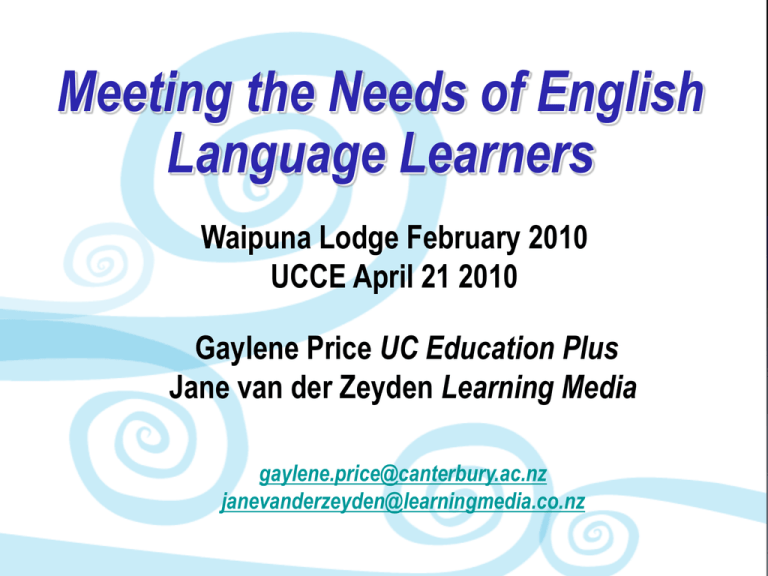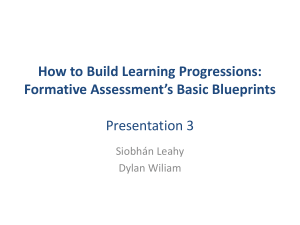Meeting the needs of English Language Learners/pwerpoint
advertisement

Meeting the Needs of English Language Learners Waipuna Lodge February 2010 UCCE April 21 2010 Gaylene Price UC Education Plus Jane van der Zeyden Learning Media gaylene.price@canterbury.ac.nz janevanderzeyden@learningmedia.co.nz Key Messages in relation to national standards Schools must recognise the diversity of English language learners and provide them with the learning support needed to enable them to access the New Zealand curriculum at age- appropriate levels as soon as possible. This will be achieved through policies, processes, teaching and assessment practices, professional development, the equitable use of resources and through effective communication with families. P.2 Meeting the needs of English language learners module Accelerated progress must be the goal for English language learners. A sense of urgency and the need to “catch a moving target” are key messages for schools and teachers. Schools will need to make informed decisions on whether to use the English Language Learning Progressions (ELLP) to track, monitor and report on English language learners progress and achievement in reading and writing. Which students are we referring to? ESOL funded students from migrant, refugee or NZ born backgrounds Previously funded students Students from homes where a language other than English is spoken Students transitioning from kura to English medium-learning environments Students from bilingual education settings Students with specific identified language learning needs International fee paying students The facts •There are over 27,000 ESOL funded students in primary and intermediate schools. They come from 163 ethnic groups and speak 115 different languages •1,022 primary or intermediate schools have funded students. •Samoan students account for 12.31% of funded students, Tongan 12.30%, Chinese 7.9% •2 schools have 300+ funded students BUT •195 schools have 10-19 students •593 schools have 1-9 students or 47.6% of funded schools It is estimated that 22% of our school students come from a language background other than English Source: Ministry of Education 2009 ESOL database The bigger picture The New Zealand Curriculum is supported by both the Literacy Learning Progressions and the English Language Learning Progressions. Learning Areas and Language Students who are new learners of English or coming into an English medium environment for the first time need explicit and extensive teaching of English vocabulary, word forms, sentence and text structures, and language uses. As language is central to learning and English is the medium for most learning in the New Zealand curriculum, the importance of literacy in English cannot be overstated. (The NZ Curriculum, 2007:16) It is important to have the same end goals in sight for all learners, but also focus on the specific language needs of English language learners in order to make progress to the same proficiency in as short a time frame as possible. ) What the national standards say: Guidelines for English Language Learners in Years 1 to 4: Students working within Foundation and Stage One of the English Language Learning Progressions may be tracked, monitored and reported on to parents using the English Language Learning Progressions rather than National Standards for a period of up to two years. Guidelines for English Language Learners in Years 5 to 8: Students working within Foundation, Stage One, or Stage Two of the English Language Learning Progressions may be tracked, monitored and reported on to parents using the English Language Learning Progressions rather than National Standards for a period of up to three years. Why would schools choose to use the English Language Learning Progressions to monitor, track and report progress? •It enables teachers to better identify the learning needs of English language learners. •The English Language Learning Progressions contain specific detail to help teachers understand the language learning process. •The English Language Learning Progressions provide indicators and next steps for teachers based on sound theories of additional language acquisition. •It may be inappropriate to use national standards which involve tools and /or processes that have been normed for native speakers of English. Scenarios In groups read the scenarios and decide a. would the student fit the criteria for tracking, monitoring and reporting using ELLP ? b. If so, why would it be more appropriate for this student? Purpose of the English Language Learning Progressions (ELLP) The progressions explain what teachers need to know about English language learners to maximise their learning and participation. They will enable teachers to choose content, vocabulary and tasks that are appropriate to each learner’s age, stage and language learning needs. The progressions are intended primarily for teachers of English Language Learners but are also useful for teachers of any students who would benefit from additional language support. Overview of Document The English Language Learning Progressions provide a nationally consistent set of progressions for teachers to use, to: identify stages and patterns of progress in the language development of English language learners in years 1-13; analyse the complexity of oral and written texts; monitor and report on English language learners’ progress. The progressions are presented in four booklets: Introduction / Years 1-4 / Years 5-8 / Years 9-13. (ELLP, 2008, Introduction, p.2) The English Language Learning Progressions will help you to find answers to questions like these: How do I know the level of English proficiency a learner has? •How do I know where to start with a learner? •How do I know whether a text is easy or difficult for my learners? •How do I know if my learners are making the expected progress? •What are the important things to know about learning in an additional language? • • • • What do learners need to know, understand and produce at different stages of English language acquisition? How do I decide what to teach, what materials to choose, and what types of learning tasks to design? How do I help my learners to become effective listeners, speakers, readers and writers? What are the next steps that my learners need to take in order to make progress? p.3 The English Language Learning Progressions, 2008 Mind Map or Ripple task Key Message ESOL pedagogy will benefit all students How does it all fit together? A suite of resources English Language Intensive Programme (ELIP) Supporting English Language Learning in Primary Schools (SELLIPS) Making Language and Learning Work 3 DVD Language Enhancing Achievement of Pasifika (LEAP) Selections Series Learning Through Talk ESOL Funding Assessment guidelines ESOL Progress Assessment MOE CD Roms (texts) Sounds and Words Effective Literacy Practice Fa’afetai lava Vinaka vaka levu Doh Je Dank U Wel Evxaristo Thank you Gaylene Price Jane van der Zeyden






